The Definitive Guide to the British Museum, London
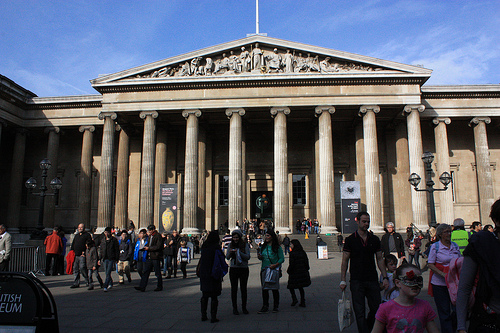
For years, The British Museum in London was like a book I’ve cracked open a dozen times, but was never able to get passed the first chapter.
I knew its beginning pages almost by heart. The crowds in front of the Rosetta Stone are mentioned in the dedication. This little one-eyed bird made an appearance in Chapter One:
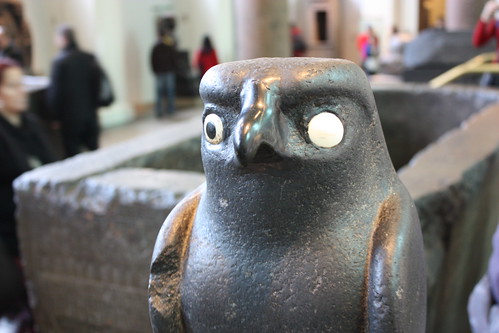
–
But I didn’t know much more than that. Did the two leads who once hated each other finally succumb to their growing passions? Did the weather worn detective ever discover who the killer was? Beaten down by jetlag, I never found out. I just reread the first chapter, and left.
This time, though, I was determined to get through every page of the British Museum. Or at the very least, skim them enough to have an idea of what was going on.
I arrived just after the museum opened, around 10:30. I’d been up for more than five hours. That’s the advantage of jetlag. The girl who sleeps until 9:30 on weekdays is suddenly an early riser. Fatigue was hitting me, but I was determined to ignore it. I refused to acknowledge what time it was back home (answer: bedtime).
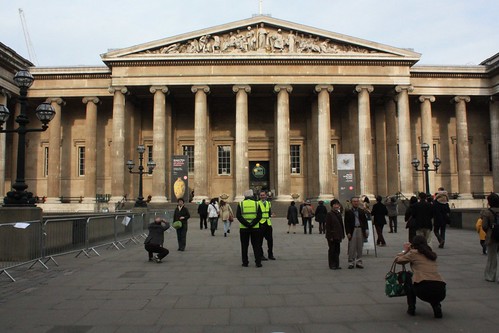
Only a few people there at this early hour.
–
BUT I WOULD NOT SLEEP. I was going to dig through every corner and crevice of the British Museum. I was going to probe its innermost depths, plunging into every cavity and …
This sounds vaguely dirty, doesn’t it? And it sort of was. If the British Museum were a novel, it would be an equal mix of high brow and smut, gore and beauty. Huge bits of it are plagiarized, too. Indeed, the British Museum features entire temples plucked from other countries, which it refuses to give back.
Had I known the story was this juicy, I’d have read it from cover to cover ages ago.
But tackling a tome as massive and unwieldy as the British Museum is near impossible, so I created this post. It’s kind of like the Cliff’s Notes of the museum. You won’t pass the final exam based on these, but you will have a good idea of what to see therein.
And yes, I realize this list is very Egyptian and Greek-centric. I didn’t even touch on Asia or the Middle East, not to mention Northern Europe. But the artifacts that I focused on are some of the most popular, lovely, and controversial in the museum (and they might not be on display there forever). So I’d recommend seeing these first, and then tackling whatever else tickles your fancy.
—————
Philosphers’ Busts, The World of Alexander, Room 22. (Left to right, Sokrates, Antisthenes, Chrysippos, Epikouros.)

Though my knowledge of philosophy extends not too far past what I learned from Bill and Ted, I still do enjoy having a face to put to some of those brilliant minds.
–
—————
Lely’s Venus (Aphrodite crouching at the bath), Greek and Roman Sculpture, Room 23.

–
I’ve always loved this sculpture. She’s beautiful and vulnerable. Plus, as this next photo will illustrate, she is lovely despite packing some serious junk in her trunk. Which is something that I, as a wide-posteriored gal, can appreciate.

Cosmo says you’re fat, but I ain’t down with that.
–
—————
Colossal Statue of Ramesses II, the Younger Memnon, Egyptian Sculpture, Room 4.
 –
–
I love this for so many reasons:
- I know he’s just a huge chunk of stone, but dude. Those are some nice pecs.
- I’ve always been a sucker for anything Egyptian. I even dated a guy in college who was Egyptian, and it was mostly because I liked pyramids. (He was all kinds of wrong for me but he introduced me to Rand, so I figure we’re now squaresies.)
- This sculpture apparently inspired the poem “Ozymandias” by Percy Bysshe Shelley. A poem which features into the plot of The Watchmen comics. Which caused me to GEEK OUT.
–
—————
The Nereid Monument, Lycian Collection, Room 17.
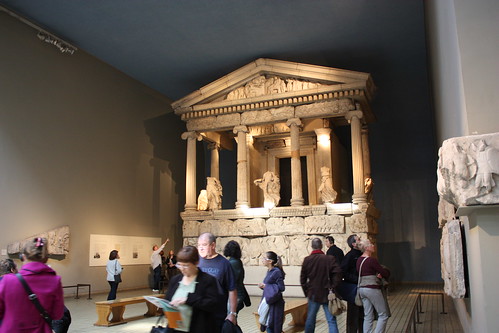
–
They’re recreated the entire facade of the friggin monument, taken from Greece by an Englishman about 150 years ago. I put aside my ethical qualms about this issue, mostly so I could sit and marvel at it. You should, too. You can protest later.
They’ve also reconstructed many of the statues that decorated the building, which was believed to have been a tomb for Arbinas, who ruled Western Lycia somewhere around 400 BCE (translation: really fancy grave for a dude who ruled a really long time ago).

—————
The Parthenon Sculptures (aka, The Elgin Marbles), Ancient Greece, Room 18.
These pieces are another issue of controversy, as they were taken from Greece nearly two hundred years ago with permission of the Greek heads of state. The Greek government has since demanded that they be returned (which is entirely fair: political policy changes a lot in two centuries). But the British Museum has refused. Here’s their official statement on the issue.
The sculptures in this gallery once decorated the Parthenon, a temple dedicated to Athena (the building itself still stands, liberated of its statues, in Greece). This horse was one of four that dragged the chariot of Helios, the sun-god, out of the water at dawn. The remains of two of them still exist.
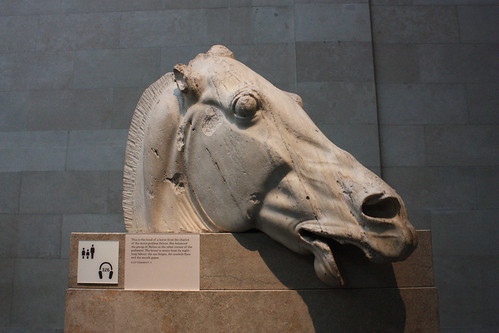
At least it’s not in somebody’s marble bed.
–
The other horse is show here, along with Helios’ arm. The sculpture was designed to appear still half-submerged in water. Which sounds AWESOME.
 –
–
Other reliefs, illustrating scenes from Greek mythology, line the room.
 –
–
Apparently they involve playing footsie with a centaur.
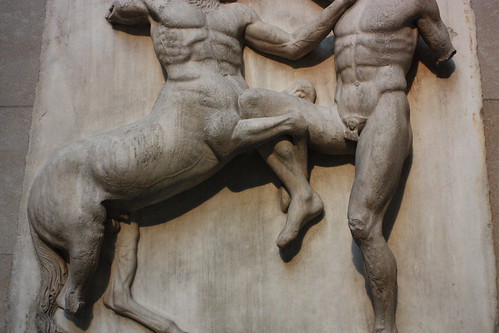
Bow-chicka-wow-wow.
–
—————
Hoa Hakananai’a moai (aka, the Easter Island statue), Living and Dying Gallery, Room 24.
Every good story needs some muscle. Star Wars had Chewy. The Godfather had Luca Brasi. The British Museum has this guy:

From the British Museum’s own website:
It has a heavy eyebrow ridge, elongated ears and oval nostrils. The clavicle is emphasized, and the nipples protrude.
Why, yes. Yes, they do.
–
—————
The King’s Library (aka, the Enlightenment Gallery)

–
This is possibly my favorite part of the museum. The room was built to house a collection of more than 60,000 books collected by King George III (clearly, a man that devoted to literature had to be a little nuts). It’s been beautifully restored, and it’s full of tchotchkes and collections that make you feel like you’ve stepped back in time.

–

This is one of the more tragic explanatory placards I’ve seen in my life.
–
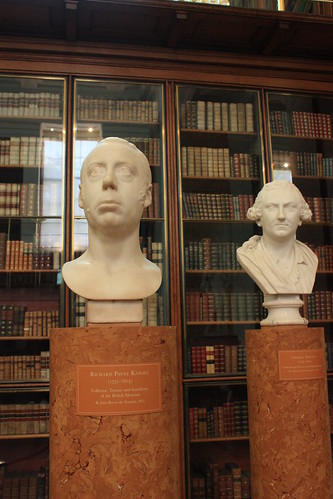
The guy on the left totally looks like Stephen Tobolowsky (look him up.)
–
But the best part of it is this:

–
It looks like just another boring bookcase, right? But it’s actually a door. Yes. Yes, I know.
There’s a small button at the right. I’ve seen a museum employee walk up, push the button, and a whole section of the wall (books and all) swing open so they could step through. The first time Rand and I saw it, we spent ten minutes daring each other to press the button.
Sadly, we both lost our nerve. But one day, folks. One day.
–
—————
Highlights from Sutton Hoo, Changing Exhibitions, Room 2 (note: this exhibit will likely move to another gallery or eventually out of the museum)
Normally I don’t find Anglo Saxon artifacts to be my cup of tea. I realize this makes me a charlatan (and that I really should stop referring to them as “Vikings-lite”).
But the artifacts from Sutton Hoo – a 6th and 7th century burial site in western England, near Suffolk – are unimpeachably fascinating. They were discovered when, roughly 80 years ago, someone noted that the series of mounds that dotted the countryside would be worth excavating.
Over the next few decades, the mounds of the Sutton Hoo burial site would yield numerous bodies and artifacts, including an interred ship that was used as a casket (presumably for someone of royal standing), as well as this helmet:

I like that the helmet looks like it has a mustache.
–
It’s an incredibly unique and extensive collection from a time period we still don’t know that much about.

At right, remnants of a lyre found at Sutton Hoo. At left, a replica of what it originally looked like.
–
Plus, you all know what a magpie I am:
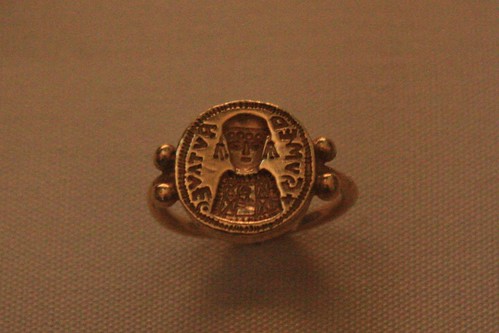
This is so awesome.
–
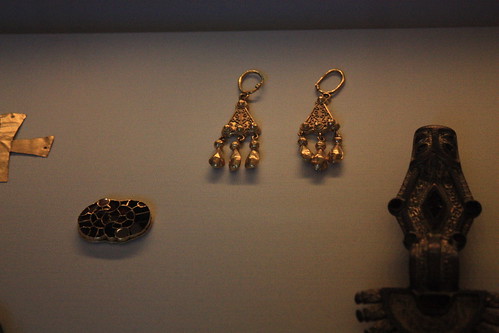
As are these.
–
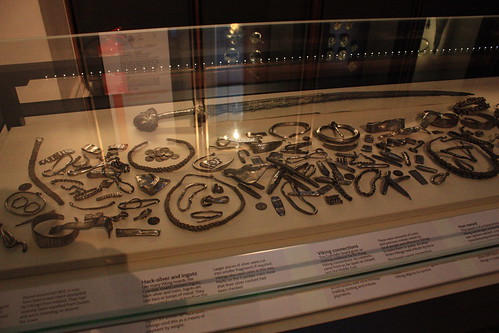
A collection of hack-silver and ingots (these were basically used as money).
–
—————
The Rosetta Stone, Egyptian Sculpture, Room 4
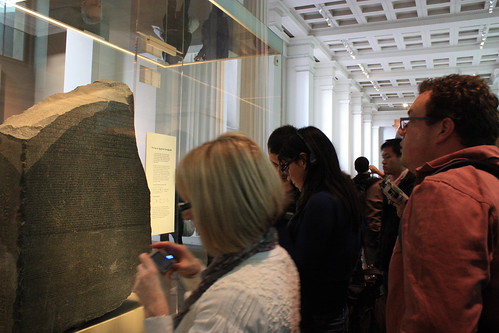 –
–
Long before people started hawking the eponymous DVDs at every single airport in the U.S., the Rosetta Stone helped cracked the code of Egyptian hieroglyphs, which were previously a mystery. The giant slab of granite has a decree from King Ptolemy V written in three different languages: the top is ancient Egyptian Hieroglyphs, the middle is another ancient Egyptian language, and the bottom is ancient Greek.
Because it contained the same text translated into three different languages, scholars were eventually able to figure out what the hieroglyphs said.
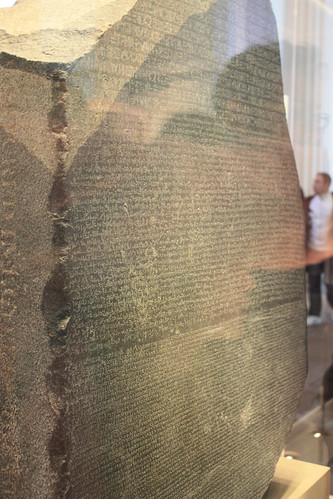
“If you can read this … you are too darn close.”
–
The stone is now the most-visited item in the British Museum. Personally, I love taking a gander at its oft-neglected backside.

–
But as I mentioned before with Lely’s Venus, I have a thing for backsides.
—————
Egyptian Antiquities and Mummies, Early Egypt, Room 64
Warning: this next section contains photos of human remains. Take solace in the fact that these people died thousands of years ago, so no one they knew personally is around to see them in their naked, vulnerable glory.
Room 64 is full of bodies. It is a tiny bit creepy, and very, very fascinating. This is the Predynastic Egyptian Man. He died more than 5,000 years ago, about 700 years before mummification was developed. Bodies were placed directly onto the hot sand, which dried out all the moisture inside, and left them well preserved. Like human jerky.

–
This guy even had hair left on his head.
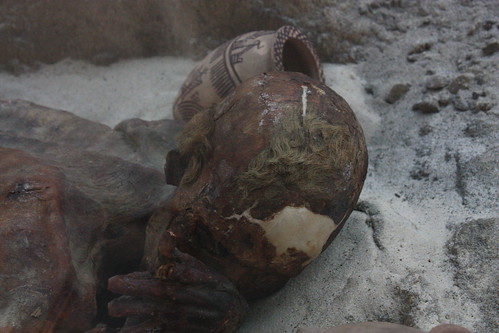
–
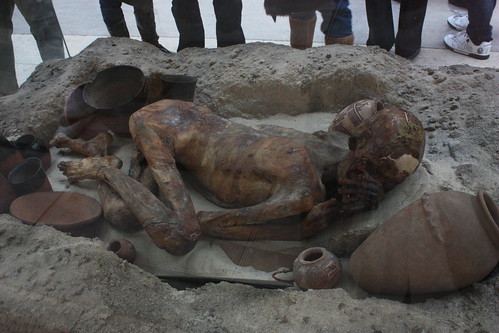
–
Seeing him curled up like that, his face shielded by his hand, made me a bit sad. Time has passed, but this was still a person at one point. I suppose it’s nice to know that he isn’t alone.
The mummy of Katebet is nearby. She was an elderly woman of high rank – a priestess of sorts.

–
And there were countless others, whose names or descriptions I did not write down. Jet lag was settling in.

–
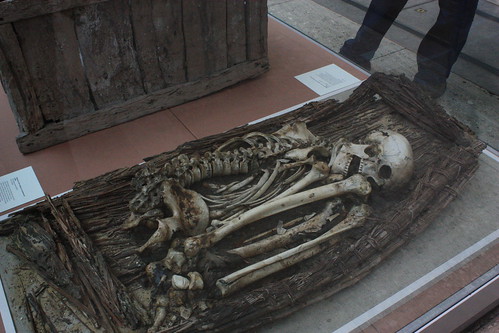
–
—————
Though I’ve never visited it, I feel compelled to tell you about the Reading Room. It’s supposedly beautiful and grand. Most of the special exhibits are housed there and require you to pay admission to see them. Cheapskate that I am, I’ve always refused to pony up the cash, and instead have enjoyed the rest of the museum, which is free.
Here’s the staircase up to the Reading Room, which is fairly grandiose in and of itself:
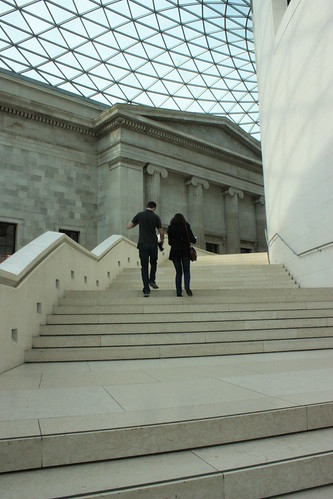
–
—————
And with that, finally satisfied that I’d seen enough of the museum, that I’d pored through at least some of the later chapters, I left. By now, crowds had gathered at the entrance, and had swarmed the more popular exhibits.
I wondered how far they’d get before, like me, they headed back to their hotel rooms for a jet-lag induced nap.

–
—————
The Essentials on The British Museum
- Verdict: Recommended, highly. The BM (heh) is one of the best museums in the world. Yes, they’ve pilfered stuff from other places. That doesn’t mean it isn’t worth seeing.
– - How to get there: Holborn, Tottenham Court Road, and Goodge Street tube stations are all close by, and quite a few bus lines stop here, too. Personally, I love staying in Bloomsbury, so I often have the luxury of just walking here.
– - Ideal for: Basically anyone. World history buffs will pee their pants with excitement.
– - Insider tips: Go early, and check out the Rosetta stone and the Egyptian rooms before the huge late-morning crowd rushes in. Admission is blissfully free, and the museum is open daily from 10am to 5:30pm, and open late on Fridays.
– - Nearby food: there’s cafes and a restaurant inside the museum (I suggest a reservation for the latter), but there’s also loads of places to eat in Bloomsbury. If you have time, considering popping out to grab a bite and a breather, then returning later.
– - Good for kids: Absolutely. Check with the information desk about special exhibits that cater to children – there are loads of school groups that come through, so the museum staff are quite used to (well-behaved) children.
Psst! Did I miss something awesome? Share your favorite part of the British Museum in the comments below!








